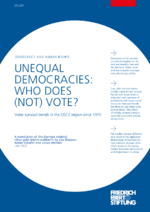Unequal Democracies
Who does (not) vote?
In Who does (not) vote? we look at voter turnout trends in 30 OSCE countries over time. We harmonized existing data sources since 1970 and made them comparable across gender, age, social class and level of education.
This is a secondary data study that harmonizes data from the following databases:
National: American National Election Study, British Election Study, Swiss Election Study, Dutch Parliamentary Election Study, General Population Survey of the Social Sciences.
Cross-national: Comparative Study of Electoral Systems, European Social Survey.
Note that the turnout numbers in the surveys tend to be higher than the respective official turnout. This discrepancy stems from Overreporting a well-known effect in empirical democracy research due to the tendency of some respondents who did not vote to not admit they violated a socially desirable behaviour. We control for this in the analysis, so the realtive voting propensities between the social groups hold. For comparison, we included both official and reported voter turnout in the visualisations.
Elsässer, Lea; Schäfer, Armin; Wenker, Jonas
Unequal democracies: who does (not) vote?
Wien, 2022
Download publication (580 KB, PDF-File)
Key Findings
Voter turnout declines – but socially unequally
Voter turnout has declined in every country analysed. However, this decline happens unequally. It is primarily the young, members of lower social classes and people with a low level of education that increasingly stay at home across all countries. This shows that it is the disenfranchised that democracy no longer reaches. Note that we did not even look at the vast groups of people in society that can not vote because of a lack of citizenship. The decline is especially pronounced in Anglo-Saxon and Eastern European countries, followed by Southern and Central European countries with the highest turnout and thus lowest voter differences in Scandinavia.
Find out more by exploring the timelines below!
The young turn their back on elections
Voter turnout is especially low among the young (under 30). The participation disparity between social classes among the young is especially high. The educated are highly politicised and engaging while the disenfranchised are especially detached from participating in their democracies. For more on democratic attitudes of young people see also our FES Youth Studies.
Social class is the biggest predictor of voting
The highest voting differences are seen between social classes. While highly educated members of the upper service class almost always vote, turnout among lower social classes has been lower and further decreased significantly over time. Our results corroborate the "law of dispersion" that a decline in turnout always happens socially unequally. It is the working class and people with low education who stay at home, while upper classes continue to vote. All those differences further increase the younger people are. Low turnout thus reinforces the disenfranchisement of economically vulnerable groups.
More...
Explore the full data set in the slideshow below


